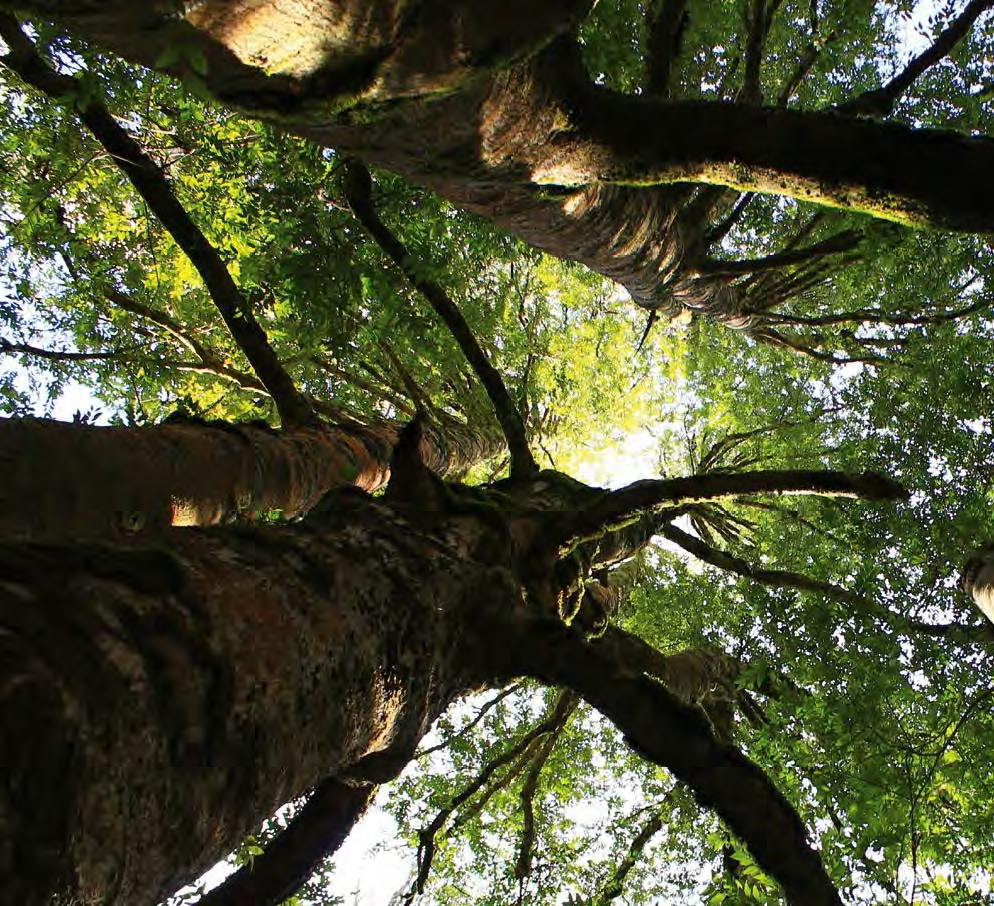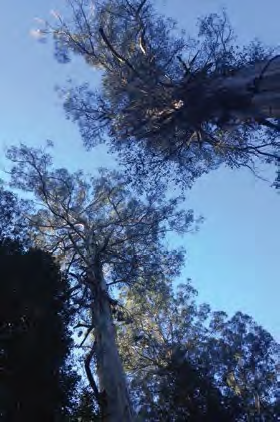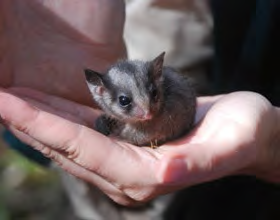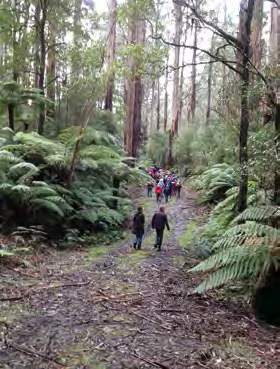
Sparkling rainforest canopy by Kevi Sanyu
There are only a few places left in Australia where one can gaze up into canopies of forests that soar above. But just over an hour from Melbourne grow some of the tallest forests remaining on the Earth.
The Central Highlands of Victoria, stretching from Kinglake in the west, to Mt Baw Baw in Gippsland, is a great place to visit for bushwalks, bird watching and some lovely forest drives.
Home to a wealth of rare native plants and animals, these forests are renowned for their tall majestic Mountain Ash trees, rich rainforest gullies and Snow Gum mountain tops. These special ecosystems and their striking natural beauty make the Central Highlands one of Australia’s most diverse and interesting tourism destinations.
Since our early beginnings as Homo sapiens sapiens, forests have been important and mystical places. Throughout time, trees have been considered sacred and honourable; oaks were worshipped by the European Druids, redwoods a part of American Indian ritual, and baobabs were significant in African tribal life. Romans and scholars during the middle ages venerated trees in their literature.
Today, a walk or bike ride along the O’Shannassy Aqueduct Trail, or a wander in the Wirrawilla Rainforest Gully, gives you an opportunity for a moment of reverence for trees and forests, too.
The Fairy (Leadbeater’s) Possum
The tall mountain ash trees, eucalyptus regnans, are known as the ‘monarchs of the forest’ and are home to native gliders - possums that fly on winged membranes, owls - including the sooty and powerful varieties, and the tiny, endangered fairy possum. You can learn more about Victoria’s animal emblem at www.ethicalpaper.com.au
Global expert on the fairy possum, Professor David Lindenmayer, says one thing that’s absolutely essential to help rescue the animal from extinction is the creation of a new great forest national park, protected from logging, in the mountain forests east of Melbourne. More about the vision for a new park on the doorstep of Melbourne is at www.greatforestnationalpark.com.au

Old tree stump by Takver
Toolangi
An ideal place to start your tour of the forests of the Central Highlands is Toolangi, meaning ‘place of tall trees’ in the language of the local Traditional Owners, the Taungurong people.
A 17 kilometre drive from Healesville along Myers Creek-Saint Leonards Road lifts you up out of the Upper Yarra Valley and straight into the land of tall trees. If you or your family and friends are looking for a night in, there are some lovely accommodation options on this road; Strathvea historic guesthouse (the only traditional guesthouse still operating in the Healesville area, please visit strathvea.com.au) or Brentwood (with gorgeous gardens, please visit www.brentwoodaccommodation.com.au).
Renowned Australian poet, C.J. Dennis, was so inspired by the tall trees and clear mountain streams of the region, he called Toolangi home for thirty years until his death in 1938. While in Toolangi township, be sure to drop in for tea at the Singing Gardens, site of C.J. Dennis’ home. More information about the history and attractions of Toolangi can be found attoolangi.net
Today, Toolangi and surrounds are an area of special importance as they were largely spared the ravages of the 2009 bushfires, making them one of the best places to experience tall, green, unburned forests in the Central Highlands.
There’s space to pull up and camp overnight at the Toolangi Recreation Reserve off Cherry’s Lane. There are toilets and some BBQs, and in the summer months you can enjoy a Saturday morning cuppa while watching the local cricket match, before heading off for a forest walk.
Otherwise, set up camp at the Murrindindi Scenic Reserve in the northern part of Toolangi State Forest; there are eight campsites sited in tall forest alongside the rushing Murrindindi River to choose from. From here, take a half hour, easy walk to Wilhelmina Falls, which for the more adventurous can be extended to a two-hour loop walk through the reserve.
Forests for Water and for Wildlife
The mountain ash forests around Toolangi are filled with amazing and unique wildlife. At night you can hear the calls of owls and gliders, and by day the forests are filled with the cheerful song of wrens, rosellas and the yellow-tailed black cockatoos.
Listen out for the mimicry of the legendary superb lyrebird. Each one tells a different tale about the myriad of different birds and other activities in the forests. In fact, sadly they have been known to mimic the destruction of their own habitat by singing the sounds of chainsaws and falling trees.
A short drive from the Murrindindi Scenic Reserve is the Wirra Willa Rainforest walk - a fantastic place to visit on hot or cloudy, misty days alike. A boardwalk traverses mountain streams - waterways that are the headwaters of the Yea and Goulburn Rivers, which flow into the mighty Murray River itself.
Characterised by myrtle beech and sassafras, this cool-temperate rainforest has a low rate of decay. Organic matter on the forest floor can be up to six metres deep. Acting as a natural sponge, the forest filters the water, drawn in by the trees, and releases it into the rivers.
Old, intact forests like those at Wirra Willa are an important part of the water cycle. Logging depletes the sources of our rivers and dams, dirtying and reducing our drinking water. These effects last for many generations, as it takes hundreds of years for a forest to produce as much water as it did before it was logged.

View across the magnificnet Central Highlands by Kevi Sanyu
Giant Toolangi Trees
For thousands of years, the Taungurung people from the north and the Wurrundjeri people from the south visited the forests around Toolangi to collect mulberry stems, which made good spears and fire sticks, to gather the delicious, starchy pith from tree-fern stems and to hunt possums and wallabies.
Around the turn of the twentieth century the first Europeans arrived. Many of the big mountain ash on the hillsides were felled by timber-getters to be split into palings and shingles for the growing city of Melbourne. In fact, more timber was logged and hauled out of the Central Highlands’ forests than was exported out of the port of Seattle from the great forests of the Pacific north-west in the USA.
Enormous stumps were left with slots in the sides where the axe-men had stood on planks to cut the trees above the buttressed base. As you tour around the Central Highlands, some of these stumps can still be seen from on road sides or along walking tracks, slowly rotting away.
But some big trees were spared the axe. Perhaps they had been damaged by fires, such as the ‘Black Thursday’ bushfires of 1851, which burned a quarter of Victoria. Or maybe they were just too rotten inside to justify the hard effort of cutting them down by hand. Maybe they were too awesome to destroy.
One of the largest of these remaining trees is now known as the ‘Kalatha Giant’.
It has survived several major fires in its lifetime. The Kalatha Giant also survived the logging that took many of the trees that had germinated around it so many centuries ago. The immediate area around the tree is now protected.
To visit the Kalatha Giant, continue along Sylvia Creek Road, and traverse the boardwalk up into the forest to see this enormous tree for yourself.

Wend Your Way Through the Acheron Valley
From Toolangi, you can head east through the Toolangi state forest across to Narbethong, then north along the Maroondah Highway towards the historic Township of Marysville, which in 2013 is celebrating its 150th anniversary.
Marysville was established in 1863 as a stopover for diggers on the way to nearby goldfields. In the 1920s it became renowned for historic guesthouses and as a popular destination for honeymooners. Marysville is now an inspiring place to visit as the town and its people recover and rebuild after the 2009 bushfires.
Pick up some lunch in Marysville, then head south towards Warburton, which, like Marysville, has been a popular mountain retreat for Melburnians since the 1900s.
A drive down the famous Acheron Way takes you through some of the forest landscape recovering from the tragic 2009 bushfires.
Further along, the road meanders alongside the Acheron River, with sweet picnic and fishing spots just a few metres off the road. As you wend your way a long this pleasant forest drive, the reddish trunks of the mountain ash trees belie the first and fertile soil of this part of the Great Dividing Range.
The eucalypt forest gives way to rainforest glades, with enormous myrtle beech trees - some hundreds of years old - framing the road, their tiny, glossy dark green leaves glistening in the sun.
Pull over at the foot of Mt Donna Buang, to take a stroll through the Rainforest Gallery - a suspended treetop walk, where you can gaze down into the rainforest understory and take a bird’s eye view of the gorgeous layers of tree ferns.
When strolling down into the rainforest gully itself, be sure to breathe deeply! The richness of the rainforest aromas are so cleansing and refreshing, with the slightly anise scent of the sassafras trees blending with the moist mountain air.

25g baby Leadbeater’s Possum by Emma Campbell
Historical Aqueduct Amblings and Timber Tramways
Another opportunity to experience different aspects of these forests is provided by the O’Shannassy Aqueduct Trail - a pathway that follows the historic open channelled O’Shannassy Aqueduct, meandering through forests that are the watershed for the drinking water for millions of Victorians.
Running from Don Valley to East Warburton, the trail currently stretches 30 kilometres. It passes through fern gullies, crosses creeks and offers some spectacular views of the Upper Yarra Valley.
Even though it’s a long-distance track, there are numerous opportunities to ‘step-on, step-off’ for short walks. More details are available from Parks Victoria at parkweb.vic.gov.au
Over the other side of the Township of Warburton, a drive into the southern fall of the Great Dividing Ranges takes you to another giant tree walk. The Ada Tree is accessed by a loop walk that takes about two hours to complete. The car park and picnic facilities at this site make it another ideal place to stop for lunch.
Spend a night at Starling’s Gap - a grassed camping area with toilet facilities and a bunch of great forest walks right nearby. This area of the Yarra State Forest provides many insights into some of the history of the region. The nine kilometre walk from Starlings Gap to Big Pats Picnic Area follows the path of a logging tramway built in the 1930s. Two hundred metres from the camping area itself, an old winch and boiler lie discarded.
From this part of the Central Highlands, depart the mighty Mountain Ash trees swaying gently in the breeze and return to Melbourne via the Eastern Freeway, within one and a half hours.

Walking in Cement Creek Catchment forest, near Warburton by Amelia Young
The Future of These Forests
If you’re planning a trip to Melbourne, making the time to head out into the Central Highlands is well worth it. The best time of year to visit is in spring and summer; you will see wildflower blooms and it will be less wet. Always check for fire risk before travelling to the forest. Autumn and winter are nice months to visit as well but be sure to wrap up warmly.
For over a hundred years, the tall, mountain forests of this area have been popular as a weekend destination, due to the fresh and restorative mountain air. Protecting these forests is crucial for the survival of endangered wildlife, for our way of life and the enjoyment and benefit of us all.
Today, we must preserve critical forest areas, and transform the logging industry. In a wealthy, developed nation such as ours, we should no longer be logging these magnificent forests for paper pulp. Be sure to visit these tall trees for yourself and to find out more, go to www.ethicalpaper.com.au
Category: Features
Written: Sun 01 Dec 2013
Printed: December, 2013
Published By: